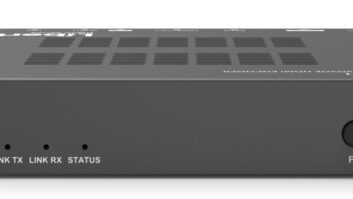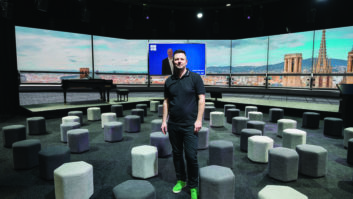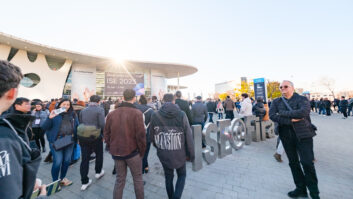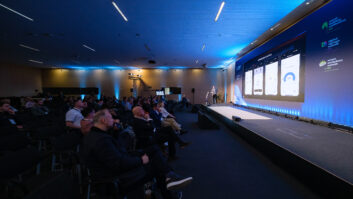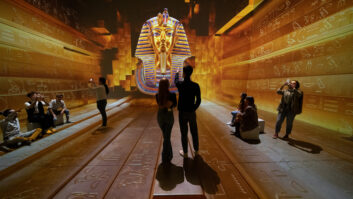With the rapid rise of immersive sound technologies for installation, broadcast and music, it has been an extremely exciting past decade for audio. But at ISE this year there was an opportunity to take a trip back to the 1960s and ‘70s – a period in which professional audio as we understand it now really took shape, and one in which there were more than a few precursors of the multi-channel, immersive sound we are revelling in today.
Billed as a ‘rare treat for classic rock and pop fans’, the Audio Museum at ISE 2024 saw the show organisers team up with CH Vintage Audio, a company run by audio historian, touring stalwart and music promoter Chris Hewitt.
Home to the largest stock of vintage music-related sound equipment in the UK, the Cheshire-based company is regularly called upon to provide historic PA systems, mixing desks, guitar amps, effects units, microphones and more for use in film, TV and music video productions.
PLASA SPRINGBOARD
But it was a presentation at PLASA in 2023 that ultimately sparked an invitation from ISE to develop and deliver an Audio Museum for this year’s show. “ISE had decided that we wanted to have a show feature to connect between Hall 7 and the walkway to the demo rooms in Hall 8,” recalls ISE head of content Joe Hosken. “It’s a few hundred metres long, so the plan we had was to showcase various pieces of audio equipment from ‘down through the ages’, tying in with ISE’s 20th anniversary theme. Last year I was visiting the PLASA Show in London and Chris had an exhibit there, showcasing some selections from his very extensive collection. So we started chatting and took things from there.”
Whilst there was a request from the show organisers to incorporate items “connected with significant events and international artists that people would recognise”, the actual selection of equipment was entirely down to CH Vintage Audio. With Hewitt’s long-held interest in audio associated with Pink Floyd, and the landmark The Dark Side of the Moon (DSOTM) album recently marking its 50th anniversary, it seemed eminently logical for some of the band’s most celebrated live gear to ‘headline’ the ISE Audio Museum.
POMPEII PA
Floyd fans visiting the Audio Museum will have immediately recognised the WEM (Watkins Electric Music) PA that was such a prominent feature of Live at Pompeii, Adrian Maben’s 1972 concert film captured at the ancient Roman amphitheatre on the west coast of Italy and structured around an epic performance of the classic track ‘Echoes’, from the previous year’s Meddle LP. But that was only one aspect of the PF presentation at ISE, with Hewitt also shipping the PA used on the original DSOTM tour – famously designed by Bill Kelsey and Martin Audio founder Dave Martin – as well as a new reconstruction of an Allen & Heath console used at both Pompeii and on the DSOTM tour.
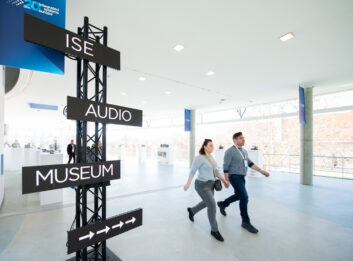 The bulk of the work involved in reconstructing the pioneering quadrophonic mixer took place in less than two months after Hewitt was approached by Allen & Heath at the aforementioned edition of PLASA. “A while later, having spoken with [current A&H MD Rob Clark], I got a call out of the blue from Andy Bereza, who was a co-founder of A&H and designed and built the original desk,” he recalls. “We started talking and he was able to provide me with a lot of information, for example how wide the channels were and which knobs were used. From that we managed to scale it up and do a drawing, thinking that the reconstruction would be a complete dummy [ie, not operable]. But then as time went by, we decided to get a couple of the channels and VU metres working.
The bulk of the work involved in reconstructing the pioneering quadrophonic mixer took place in less than two months after Hewitt was approached by Allen & Heath at the aforementioned edition of PLASA. “A while later, having spoken with [current A&H MD Rob Clark], I got a call out of the blue from Andy Bereza, who was a co-founder of A&H and designed and built the original desk,” he recalls. “We started talking and he was able to provide me with a lot of information, for example how wide the channels were and which knobs were used. From that we managed to scale it up and do a drawing, thinking that the reconstruction would be a complete dummy [ie, not operable]. But then as time went by, we decided to get a couple of the channels and VU metres working.
“We also wanted to recreate the illuminated push buttons that were originally requested by Peter Watts [celebrated Floyd roadie and father of actress Naomi]. Having rushed ‘round and bought components from around the world, we actually finished the mixer within seven weeks of drawing it out, and Andy was really involved in the project throughout.”
Audio Museum visitors had the opportunity to hear both DSOTM and the Live at Pompeii soundtrack through the historic PAs, but the Floyd was by no means the only classic act represented. Invited to select some other highlights from the exhibition, Hewitt points to the Midas desk used on the tour that followed the release of Mike Oldfield’s Tubular Bells; monitors deployed during The Beatles’ work on the album that became Let It Be (and recently featured in Peter Jackson’s Get Back documentary); compressors employed during the recording of John Lennon’s Imagine LP at his Berkshire country house, Tittenhurst Park; a mixing desk once used by Crosby, Stills, Nash and Young; a PA system utilised by David Bowie for his 1973 tour, which famously concluded with a shock announcement during the Hammersmith Odeon gig that he was retiring his Ziggy Stardust persona; and items related to Jimi Hendrix, The Who and Frank Zappa.
FORMIDABLE COLLECTION
Having amassed such a formidable collection, it’s no surprise that Hewitt’s phone frequently rings with requests to supply period equipment to film and TV productions. Rocket Man and Bohemian Rhapsody – the biopics devoted to Elton John and Queen, respectively – and The Reckoning, the recent BBC mini-series about the Jimmy Savile sexual abuse scandal, are among his many credits.
Also noteworthy was the Disney+ series, Pistol, about the Sex Pistols, which neatly brings us back to Ziggy Stardust’s last hurrah, after which Pistols guitarist Steve Jones famously helped himself to some gear belonging to Bowie’s band – an event depicted in the opening episode of the series and recalled by Jones on his radio programme/podcast Jonesy’s Jukebox.
“Quite often these projects will start with a request that gradually expands into something bigger,” says Hewitt. “So with Pistol, we were initially approached because we had a particular guitar, but during the conversation they mentioned they were looking for various PA systems and recording gear, much of which I said we should be able to provide.
“For the Ziggy Stardust [sequence], we went back into the Hammersmith Odeon [now known as the Eventim Apollo] and basically put in the whole stage PA that we fabricated from scratch. Of course, six months later someone came up to me at PLASA and said they had the [original system] in their shed in Slough…!”
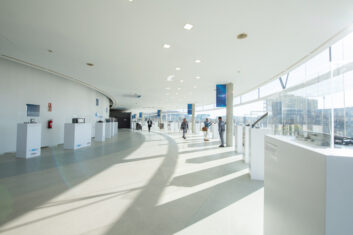 Whilst the CH Vintage Audio inventory is already extremely extensive, it’s not always easy to resist making further acquisitions. As Hewitt admits: “My problem is that I can get a bit of money for doing things like ISE and PLASA, but then spend like five times that amount in collecting more stuff!”
Whilst the CH Vintage Audio inventory is already extremely extensive, it’s not always easy to resist making further acquisitions. As Hewitt admits: “My problem is that I can get a bit of money for doing things like ISE and PLASA, but then spend like five times that amount in collecting more stuff!”
Although his focus is evidently on heritage audio, Hewitt readily acknowledges that there are direct connections to be made with today’s most significant audio innovations. For instance, the quadrophonic audio championed by the Floyd in the 1970s is an antecedent of the immersive systems that are increasingly de rigeur in the world’s leading performance spaces.
REFERENCE POINTS
“It’s important that people recognise the industry we have now has come from somewhere,” says Hewitt, who also hopes that the Audio Museum may have helped raise awareness of day-to-day audio quality in an era where so much personal listening occurs via computer speakers and mobile phones. “I think that some people do [unquestioningly] accept modern audio as being great because they don’t have proper reference points.”
He is also concerned that touring sound specifications are increasingly determined by requirements other than the actual audio quality – an inevitable consequence, perhaps, of a business that has become significantly more organised on every level since the more freewheeling days of the 1970s. So it’s by no means uncommon, he says, for tour producers to be prioritising questions like ‘what is the lightest way to truck [the loudspeakers], and how many of them will fit into a truck?’ Whereas previously it was more ‘we need the best sound and then we’ll work out how to truck the boxes’.
“Like every business in the end, it can be the accountants that make the decisions and not necessarily the innovators,” he adds.
INNOVATION COMMITMENT
The Audio Museum underlines the commitment to innovation that has always characterised pro audio since the sector began to mature. “A lot of the equipment shown predates ISE by 30 years, but many of the brands still make audio equipment and are exhibiting at the show,” says Hosken. “It reflects heritage and engineering excellence, and all the companies should be proud of that fact. It really shows that, ultimately, quality will win through.”
The exhibition also chimed with a broader theme at ISE 2024 – that of AV’s ongoing evolution across disciplines and applications. “It’s something that you could see throughout the show – that technologies and solutions continue to evolve and the ‘state of the art’ moves forward,” Hosken adds. “But it’s when the technologies are in the hands of truly creative artists that we can hear the greatest results… The Audio Museum showcased that really well by highlighting some of the key events where that unique combination occurred.”
Moreover, the fact that ISE visitors could then visit Hall 8 and step into the 14 specially- built Audio Demo Rooms – where some of the latest and greatest audio solutions were being showcased by manufacturers including Coda Audio, Holoplot, L-Acoustics, Turbosound, Lab.gruppen and Void Acoustics – only served to highlight the determination of R&D teams to deliver something new and surprising.
“It was fantastic for attendees to be able to see what was pioneered 50 years ago, then visit a booth or go into a demo room at this year’s show and experience the latest manifestations of surround sound and so on,” says Hosken. “It’s very much a continuing story.”
